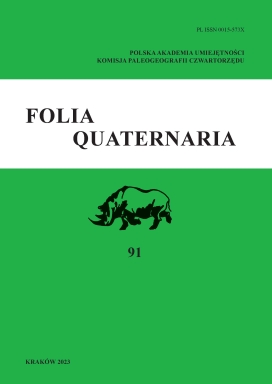Late Glacial and Holocene evolution of the estuarine section of the Nida River
Late Glacial and Holocene evolution of the estuarine section of the Nida River
Author(s): Tomasz Kalicki, Piotr BiesagaSubject(s): Maps / Cartography
Published by: Wydawnictwo Uniwersytetu Jagiellońskiego
Keywords: Estuary changes; Vistula river; Nida river; evolution river; cartographic changes; geological changes;
Summary/Abstract: Based on the results of detailed geological-geomorphological studies, old maps from the past 200 years, and historical data, the paper is the first to present the structure of the valley floor in the estuary of the Nida River, an upland tributary of the Vistula, and discuss changes in the development and course of their channels. The aim of the study was to grasp the importance of local factors, both natural (palaeogeographical, lithological and tectonic) and anthropogenic, in the morphogenesis of this section, where a relatively small upland stream crossed in the medieval and modern periods by important overland and water routes of the Polish-Lithuanian Commonwealth flows into the Vistula River, which is ten times larger. The discussed section is not deltaic in character. The branching of the Nida into several simultaneously functioning outlet arms may have been caused by the blocking of outflow from the valley during floods and the drainage of the flood waters at the valley mouth in several directions, via channels both permanent and periodic. Changes in the numbers and locations of the Nida estuaries in recent centuries have both natural and anthropogenic causes. The interaction between the main stream and its many-times smaller tributary in the studied section has resulted in a complex mosaic of forms and cut-and-fills of both streams, but with the Vistula playing the dominant role. The cut-and-fills of the Vistula “enclose” the Nida alluvium inside its valley on the Winiary-Nowy Korczyn line, while the cut-and-fills of the Nida only occur in a very narrow strip under the edge of the terrace. The Nida followed abandoned channels of the Vistula on Holocene cut-and-fill IIA, flowing parallel to the Vistula for 9 km. The floor of the Nida Valley lacks Holocene mineral-organic and mineral sediments, characteristic of other upland tributaries from loess areas. The regulation of the Vistula in the mid-19th century and the Nida in the first half of the 20th century fixed the courses of the rivers, completely changing the sedimentation regime in the estuarine section of the Nida, where backflow and associated sedimentation of fine-grained deposits occurred.
Journal: Folia Quaternaria
- Issue Year: 2023
- Issue No: 91
- Page Range: 39 - 61
- Page Count: 23
- Language: English

